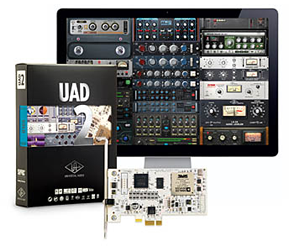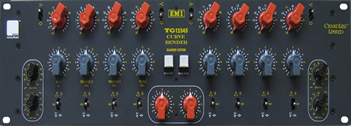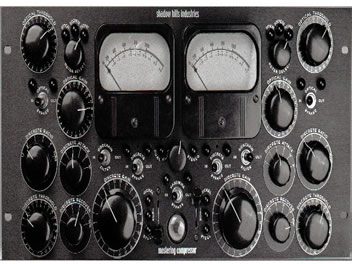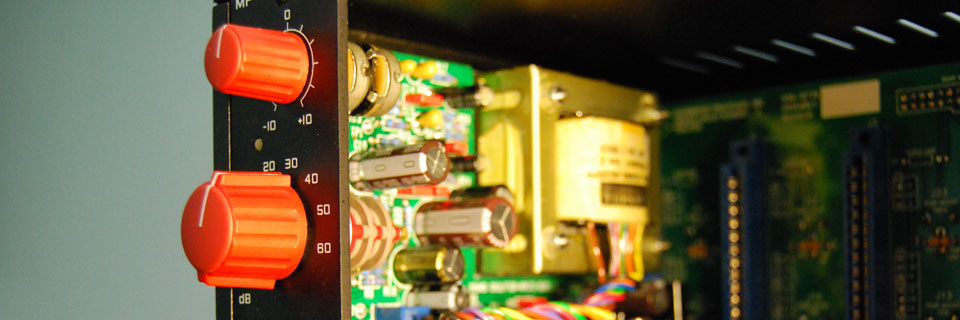The manufacturers of vintage equipment designs know well the importance of influencing opinion by posting anonymously to forums. It is no coincidence that many forum lurkers aggressively advocate high-priced vintage equipment over contemporary cost affordable technologies to their fellow surfers. Understandably this has annoyed many educators such as myself who feel that the emerging generation of music recordists are being unduly pressured into thinking that they will not be taken seriously if they use "lesser" cost effective "semi-pro" equipment.
Proclaiming that a valid music recording can only be realised with expensive "vintage" boutique designs is one way to differentiate yourself from the more cash strapped masses like you and I, but never forget that the cost, or "objective" quality (more on this later), of a given piece of gear is irrelevant to its creative potential. Freddie Mercury's lead vocal vocal for Bohemian Rhapsody was recorded with an Shure SM58 in the control room without headphones.
It is not my intention to rubbish any particular approach to recording or era of technology here, but merely to remind us that there are no right and wrong methodologies or designs, only different ones. Contrary to what some would have you believe, the 50, 60 and 70s are not the only decades in which valid music recordings were made, but it is true that many "characterful" pieces of equipment were designed and employed back then. It is also true that many of their designers now regard those designs as flawed and have progressed in recent years to design technically superior more transparent equipment utilising better quality modern components.
So, the purpose of this short article is to de-bunk some myths and help the new and less experienced generation of emerging sound recordists and performers to make some sensible decisions in buying the "right" equipment. And of course to rubbish those that maintain only their views and equipment choices are valid!
Equipment
I'm going to divide equipment into 3 categories. You may feel these are somewhat arbitrary but they serve the purpose of my thesis.
- Hi-end equipment that attempts to be as transparent as possible, regardless of cost, neither adding or subtracting harmonics and "artifacts" unless the user chooses to.
- Equipment that seeks to be transparent but, usually for cost reasons (design, components etc), falls short.
- Hi-end vintage equipment that seeks to alter the audio being passed through it, usually for creative esthetic reasons.
Focusrite ISA430, a hi-end channel strip

DPA 4004 reference mic

1 Hi-end "transparent" designs
Here we are talking about equipment that seeks to process an audio signal without adding noise or disturbing its harmonic structure or timbre. A piece of equipment may for example ...
- Amplify a signal without artifacts from microphone to line level
- Control the dynamic range of a performance without introducing unwanted distortion
- Correct an undesirable artifact introduced by some other process or piece of equipment
The vast majority of the analogue and digital equipment available up to the end of the 1980s was unable to do this with anything like 100% success. The quality of available components and technologies was not up to the job. In the fields of popular music recording this was not necessarily a problem, as much music production was technology based and preoccupied with sonic invention and discovery, but it was a big problem for an engineer attempting to capture as faithfully as possible a classic or acoustic performance.
Today we have equipment that, though not perfect, is to most peoples ears (engineers included) capable of close to transparent operation. High quality components and fast processors are able to deal with low noise, wide dynamic range and frequency responses beyond human hearing. I am sure I am not alone in having encountered a performer who neither required or wanted their musical facility (either vocal or instrumental) altered by available recording technologies. I'm talking about a musician who has complete control of the dynamic range of their performance or a singer who has spent years fine tuning their voice to exactly the timbre they want. They merely want the performance captured unaltered.
A good example of a design that seeks to enable an engineer to capture a performance transparently is Focusrite's ISA430 channel strip, a device that incorporates many of Rupert Neves modern design ideas. You are not required to like devices such as these, many engineers regard them as "clinical" sounding, but you should acknowledge that they are high quality devices capable of amplifying and processing a signal from a microphone or other source with minimal disruption.
Another example would be an analogue to digital converter capable of at least 24bit 48KHz operation and with good jitter rejection and a well designed anti-aliasing filter. High cost alone is not necessarily an indication of these qualities and it can be very difficult to choose a device even under controlled A-B comparison. Even cost affordable devices are capable of excellent performance and the differences between hi and lo-end devices are often so subtle it is very difficult for even the well trained ear to detect them, certainly within the context of a busy mix.
A final example might be a good quality FTET condenser microphone. Not valve, and not large condenser (these types are designed to alter, or "flatter" the sound of a performer), but a small diaphragm, omni directional example such as those made by Earthworks or DPA. Of course you will need to consider the effect of the recording environment when using them.
If you are seeking to make the highest quality transparent recording, you should use devices such as these, designed for purpose. Avoid "characterful" valve and pre 1980s technologies.
Universal Audio's affordable PCI DSP hardware plug-in
emulations card

2 Affordable "transparent" designs
As we know, high quality affordable (mostly digital) equipment has been responsible for the demise of much of the "traditional" professional recording industry. Super powerful PCs, DAWs, converters, effects processors, instruments and software emulations have all had an impact, but on the analogue side of things, whilst affordable high quality microphones have flourished, the same cannot always be said for mic pre-amps, eq and compressors where quality still costs. Much affordable analogue equipment that seeks to deliver high quality transparent operation falls short due to unavoidable comprises in design, components and assembly.
However, this does not mean that such equipment cannot produce exactly the result you are looking for. If a budget mic and pre amp setup gives you the sound you are seeking, why upgrade? Remember that the quality of much "home" or "semi-pro" gear far exceeds that which was available to the Beatles when they were recording, in terms of transparency if not "character". I have lost count of the number of times I have discovered that a piece of equipment, which I had previously found to be unusable, was instrumental in a favourite recording made by another producer.
In short, the quality gap between affordable and hi-end digital equipment is usually narrower than analogue, but any given combination of cost effective devices may produce the results your are seeking.
Teletronix LA2A, a classic analogue hardware electro-optical
valve compressor

Chandler Limited Curve Bender eq, derived from a 60s EMI design

Shadow Hills mastering compressor

Telefunken C12 - an AKG C12 "clone" re-issue

3 Hi-end vintage designs with "character"
It is mainly in the arena of hi-end vintage equipment that subjective opinion is most often pedaled as fact. So successful have the marketing departments of certain manufactures been that many contemporary brands and designers have had to introduce models at odds with their initial mission statements (Brauner comes to mind with their valve sounding FTET mics) in order to flourish. In technical books of merely 10 years ago you would be lucky to find more than a handful of pages given over to the subject of compression. Today you'd be forgiven for thinking that compression is more important than the music!
Although this skewing of common sense attitudes to recording is currently at its zenith, it is true that one of the joys of recording is in discovering the differing characters of hi-end vintage analogue (and sometimes digital) equipment. Devices that "enhance" and alter the basic timbres of performers and instruments can play a hugely enjoyable part in the creation of creative recordings
Most of these devices are incapable of processing a signal without adding something to it, hopefully "improving" it, and there is nothing wrong with a recording methodology that employs sound manipulation of performance as an essential creative element. Sound recordist often use expressions such as "warmth", "character", "punch", or (my favourite!) "creamy" (whatever that means!) to describe the effect they have on a source signal, but you could just as well say "distortion", "noise" and "dirt". Perhaps we love them because all too often we are working with inadequate sounds or performers. For example, I know that my singing voice is greatly improved by a large capacitor valve mic and a certain vintage mic pre!
Although often seemingly over-priced, much vintage gear is expensive because of economies of scale and labour costs for hand assembly. For me the attraction is discovering a designer who has a creative and personal view on some element of sound shaping, and who has developed a device with "personality". I love using the products of enthusiastic and committed boffins, it is the antithesis of much of the corporate mass produced technologies we all rely on day to day.
Whether you like the sound of much of this equipment is down to personal preference. Do not be fooled into thinking that because a piece of gear cost thousands and has a prestigious manufacturers badge on it that you are going to like it. Many boutique designs polarise opinion, and that's exactly how it should be. Also it is important to acknowledge that, as with all equipment, a given piece of gear will not necessary be suitable in every recording situation.
Conclusions
Most evaluation of equipment is personal opinion. In fact the only "meaningful" and "objective" evaluation you can make is a purely technical none-musical one, perhaps by assessing jitter, transparency or the flatness of frequency response etc. But even this kind of evaluation is of limited use unless you are involved in mastering or duplication.
How dull it would be if we all agreed on the best combinations of equipment for recording tasks, then all our recordings would sound the same! Thank god for those true innovators (Les Paul, Bill Putnam, Prince, Kraftwerk etc) who broke down barriers to give us such an abundance of choice. It still amuses me to see an engineer route a Shure SM57 (affordable) through a Neve pre-amp, Massenberg eq and Teletronix LA2A combination. Nothing wrong with this, I've done it myself, but there is still something wonderful about the quality/cost imbalance!
Neve 1073 mic pre and eq

Perhaps I can end with a refection on 2 pieces of equipment that I have used. They are the much loved Neve 1073 mic pre-amp designed in the 1970s, and the Focusrite ISA430 MkII channel strip processor, which incorporates much of the ISA circuitry commissioned by George Martin in the 1980s for his Air studio facilities. These are good examples to compare because they were both largely designed by the esteemed British designer Rupert Neve, and at the time he designed them he was attempting to create the most transparent hi-end processors possible with the then available components.
From a technical point of view, the 1073 is vastly inferior to the ISA430. It is noisier, adds more harmonic distortion, has a more "compromised" frequency response and a 'poor' slew rate, meaning it softens transients. The ISA430 is efficient, transparent, has a wide dynamic range and flatter frequency response. The designers of the ISA430 also acknowledge that different microphones behave differently according to the impedance of the device they are plugged into, and so have included a facility to impedance match.
Which is better? Neither. They are simply different. Rupert Neve has said that the designs in the ISA430 are vastly superior and we should choose them. But that's just his opinion! For me they are both brilliant and neither is suitable for every situation. I love the colour that the 1073 adds to electric guitar and vocals, and the way it smooths those spikey saliva pops!, and I value the transparent sound of the ISA430 on vocals, steel strung and nylon acoustic guitars and percussion. You may have an opposing and equally valid opinion.
So my final message is this. You can seek advice and opinions on acquiring the right gear but try to ensure it is impartial and helpful. If you are not capable of making a decision by auditioning equipment by yourself, then seek the help of an experienced impartial professional (not a salesman!) who you can trust to guide you. Comparing equipment (especially mic pres) can be very challenging in terms of access to equipment, suitable environment, performers, time and methodology. And remember that there is no good and bad gear, only gear that you like or dislike. In time you will find exactly what it is that you like, but even then you may find your preferences "mature" over time as fashions change.

